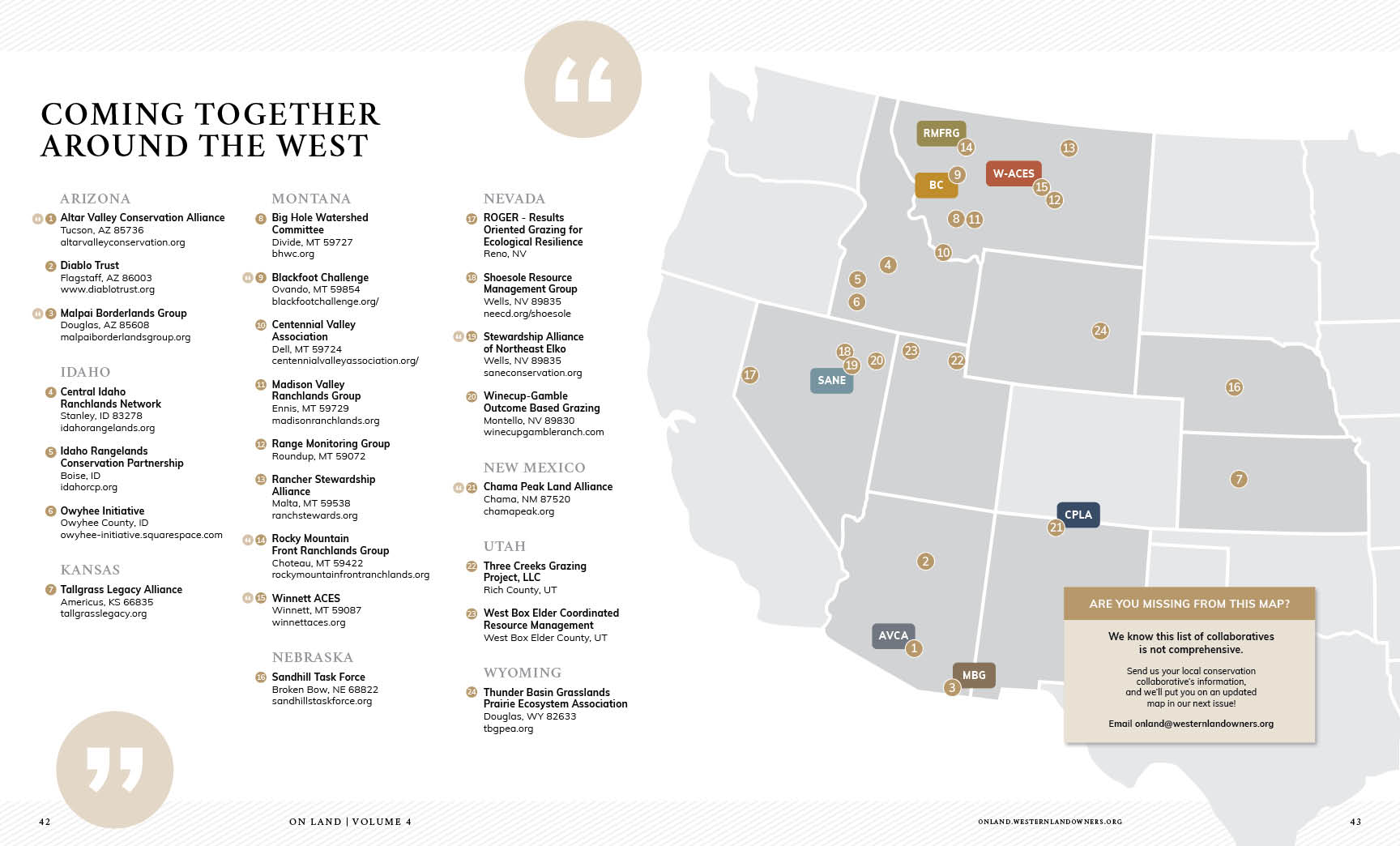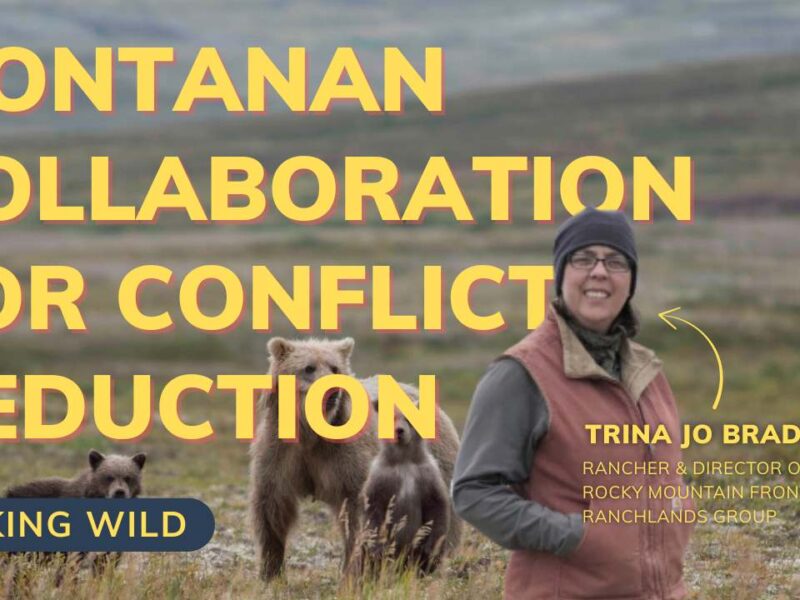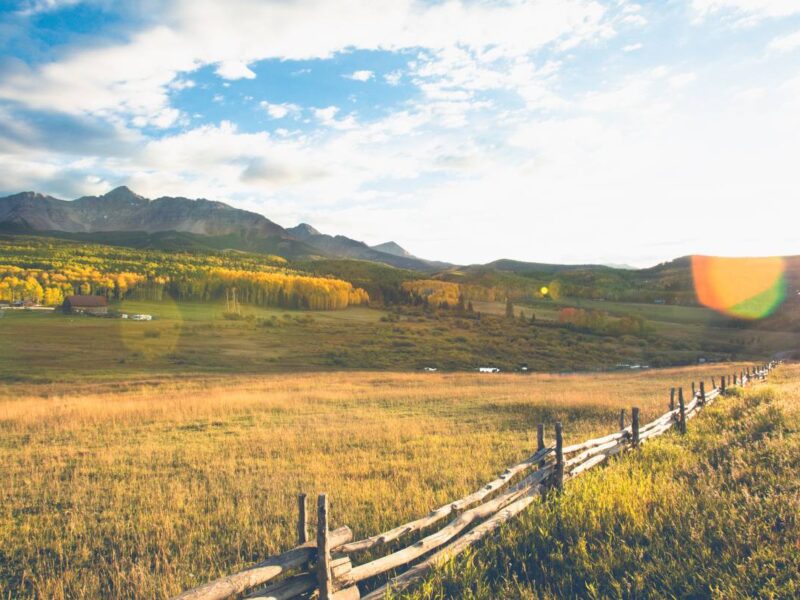Coming Together Around the West
Collaborative Conservation Leaders Sound Off
Beginnings
Malpai Borderlands Group (MBG) est. 1994
“We formed as a nonprofit in 1994 to address intact landscapes, open landscapes and [protecting] pastoral traditional livelihoods on the landscape there. Ranchers in our area were identifying the fact that there was a division in the early ‘90s between the environmental community and the ranching community, and lots of talk about what their differences were. We formed with the idea of having a place to talk about what we had in common, in terms of collaborating on conservation.”
– Rich Winkler, Rancher and Executive Director, Malpai Borderlands Group
Chama Peak Land Alliance (CPLA) est. 2011
“The need to share information. At the most basic level, that’s one of the most important reasons the organization started. So ranchers realizing that there’s all these things happening, all these opportunities, all these challenges and people want to be informed. They want to talk to each other. They want to share information. I’ve heard one of the reasons why we formed was a good excuse to get together and have a beer. And I think that’s still true today.”
– Caleb Stotts, Executive Director, Chama Peak Land Alliance
Blackfoot Challenge (BC) est. 1993
“There had been lots of conservation going on since the ‘70s in the Blackfoot; so way before my time. It was just sort of in our DNA to try to do the right thing. And they were communicating with partners, which back then wasn’t really very sexy to do. And in our watershed, there are seven different communities. And I think that’s the piece that struck me. Up to ‘93 when the challenge started, we hadn’t really focused on the communities at all. The light bulb for me was that all this stuff that we talk about every day: there’s one common denominator and it’s people.”
– Jim Stone, Rancher and Executive Director, Blackfoot Challenge
Altar Valley Conservation Alliance (AVCA) est. 1995
“We got started in response to both pressures from Tucson and development, as well as looking at some of the landscape goals for conservation–prescribed fire, erosion control in the Altar Wash — and thinking about how those could be achieved more effectively by working across boundaries, working at a bigger scale.”
– Sarah King, Rancher and Executive Director, Altar Valley Conservation Alliance (AVCA)
Winnett ACES est. 2016
“We had a neighborhood meeting, just a bunch of producers, people from a broad spectrum of the community. And the question was posed, ‘how do we want to deal with sage grouse and elk?’ The conversation went around the room, ‘yeah, we have wildlife issues and issues with how federal agencies are telling us how to handle wildlife issues.’ But the bigger issue we felt was the community. How do we keep our community going?”
– Laura Nowlin, Rancher and Executive Director, Winnett ACES
Stewardship Alliance of Northeast Elko (SANE) est. 2012
“In 2012, this SANE group started up when the sage grouse listing threat was here at that time. And so, coming together was more of a shared threat and common enemy, for some I suppose. I think that oftentimes in the West, it has been a threat that has been the impetus for a lot of these things to come together. [But] I don’t think it has to be. I think if you believe in what it represents: grassroots democracy and civility, then, you know, it can have a deeper meaning that can be implemented and realized on the landscape and within the community, and through the economies of maintaining and sustaining those.”
– Robin Boies, Rancher and Executive Director, Stewardship Alliance of Northeast Elk
Rocky Mountain Front Ranchlands Group (RMFRG) est. 2021
“So what first brought us together was that where we live in northern Montana is grizzly bear and wolves [number] one to one to our cows. We got started because all of us have grizzly and wolf problems. So, we are working a lot on that issue. RMFRG exists to preserve working family ranches, farms and rural communities by carrying on the traditional conservation practices that have supported and protected our landscape for the last 100 years.”
– Trina Jo Bradley, Rancher and (volunteer) Executive Director, Rocky Mountain Front Ranchlands Group
Challenges
AVCA “We started in 1995. I think 2010 was the first time a program administrator got hired. We had a couple of people who were really passionate about volunteering their time, which is probably what stretched out that 15 years to let us get away with a lot of volunteer work. What really helped us get over the hump was getting better about building the capacity stuff into grants and acknowledging that it did take time and effort to pull it all together and that it didn’t just magically happen.”
– Sarah King
MBG “We still remain under the volunteer model. We have three part-time staff, including me. Very part time. I am a rancher. I run our family’s ranch. Most of our board members do so as well. I think it is important to keep that component of an organization, where people are actively volunteering. You’re never going to get away from that struggle.”
– Rich Winkler
CPLA “I see [maintaining funding for staff] as definitely a challenge, but it’s better than the alternative, where, if there is no employee and it’s all on the backs of volunteers, then you really run into that challenge of asking a lot of people. For folks who basically have more than a full-time job running a ranching operation, any time doing all this can be a lot to ask.”
– Caleb Stotts
SANE “I was thinking capacity, too. … I hated to even say the word. I wish we could think of a new word because it’s just been such an issue for so long, but it’s real. It seems like the states that have really addressed this, they’re getting general funding from the legislature and they’re standing up these local organizations with what they need. And states who aren’t doing that and really putting their money where their
mouth is about conservation and local,
they just are struggling.”
– Robin Boies
RMFRG “We’ve only been in existence for a year and a month. We’re not a nonprofit yet, and we don’t have a bank account yet because we don’t have any money. And I am the only one that works here, for free.” – Trina Jo Bradley
😂 “It’s like a ranch!” – Amber Smith, Ranchers Stewardship Alliance Board Member, WLA Women in Ranching Program coordinator
Successes
W-ACES “We looked at the Nature Conservancy Matador grass bank and decided that that seemed like a good way to both take care of the land and also offer opportunity to local ranchers, in particular, young producers who don’t have access to grass. Now, we’ve kind of shifted from calling it a grass bank to calling it a ranch incubator in recognizing that the conservation goals are important to us, yes, but also maybe more important is the opportunity that it would present to producers to establish a business or grow a business and the economic opportunity that that would provide the community.”
– Laura Nowlin
MBG “There has been a whole variety of different projects that we’ve worked on, from wildlife fences to solar water wells, reducing erosion, rangeland monitoring. You name it. And obviously within family ranches, succession is an issue. Making a living through pastoral ranching, a lot of families’ younger kids were not coming back to family ranch, so we made succession an important part of our work.”
– Rich Winkler
AVCA “We are focused on common ground. We haven’t been divided by trying to focus on creating agreement on issues where there’s not going to be agreement. But we’re really focused on what we want to do for the land, the conservation actions that we want to do, what brings ranchers together and how to work with partners throughout the valley.”
– Sarah King
BC “When you see agencies start asking local communities to be on hiring committees, and all of a sudden it’s written into policy within the Forest Service and BLM that they need to sit on these local collaborative groups. We’ve made a dent.”
– Jim Stone
SANE “It was a big shift to come together and share information and share power and work together. It was like saying, ‘No, we’re not going to be part of the machine.’ It was Star Wars stuff. Because story is such an important part of this. There’s a lot of mythology surrounding the West that has driven us to where we’ve ended up. You can change that story and create some new mythology eventually. The projects and all of the meetings and bringing agencies in — it can result in that, maybe not in my lifetime, but in another 50 years, if it doesn’t get lost.”
– Robin Boies
RMFRG “We did a Guardian Dog Workshop in December. There I was explaining how we got started and I told everyone that first I talked to the people that I’ve known the longest: my dad and another rancher that might as well be my dad. I knew if I got them on board, the rest would be cake because my dad had told me I was wasting my time. My dad is now on my board of directors, as is the other guy.”
– Trina Jo Bradley
CPLA “In recent years, the public has realized the importance of watershed health. With all this drought, with wildfires, with population growth: as a society we are recognizing just how important water is and how important watershed health is to the water resources that we need.”
– Caleb Stotts





